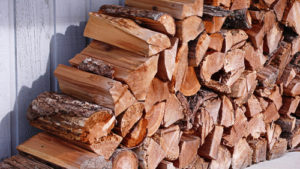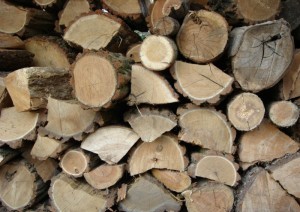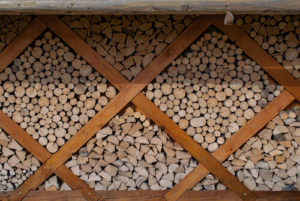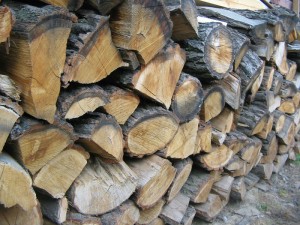by Mark Hudson | Nov 29, 2018 | Firewood
At this time of year, it may be difficult to find firewood when you need it. Why? Because many suppliers have been selling out their supply for months and any wood you cut now will not be good for burning. In order for your fireplace, stove, or insert to work properly, you must burn only properly seasoned firewood. This means your wood should be cut many months before burning, and stored until winter.
Can You Burn Fresh Wood? 
Yes. You CAN burn freshly cut wood. If your family is freezing, and the only wood you have to burn is freshly cut, it will burn. It will be difficult to light, will not reach a high temperature, will burn incompletely, produce more smoke than heat, and will put more creosote in your chimney than necessary. To reach the desired temperature, a homeowner may use three times more wood than you would with properly seasoned firewood. This wastes fuel and damages your system.
Properly Seasoned Wood
Your firewood was once a live tree which stored and used water in order to live. When it’s cut, it likely has a water content higher than 75 percent. When you burn this “green” or “wet” wood, it has to first evaporate the water before burning the fuel (wood). Think about it like this: you’re camping in the rain and attempting to light a fire. Would you use wood that has been soaked with rainwater, or would you dig through brush and grasses to find dryer pieces? Firewood is the same. The best-burning wood is cut and allowed to dry for 3-6 months before being burned. This ensures a water content of less than 35 percent.
DIY Seasoned Firewood.
First, find a good supply of the type of tree you’d like to harvest. Harder species of wood burn differently than softer ones, but all will burn well when properly-seasoned.
Next, cut the tree down, and cut it to the desired length. Letting the wood sit like this will allow water to drain and evaporate from the ends faster than letting a felled tree dry. Letting the whole tree sit will likely result in a rotted tree, not seasoned firewood.
Finally, store the firewood until you need it. If you wait to split your firewood until it’s dry, it will be easier to split and lighter to carry.
Buying Firewood
It may be that you do not have a good source for firewood on your land. You can still have a wood fire by purchasing seasoned firewood from a local supplier. When searching for a supplier, look for wood that is cut and stacked in piles that look seasoned. It is seasoned firewood if it is gray in color, light in weight, has cracks along edges, and the bark pulls away from the flesh. Don’t pay too much for a cord or rank of wood. Make sure you understand what these terms mean, and how much you should be paying.
How to Store Your Supply
Whether you’re storing bought or self-cut wood, use an open pile, a tarp, or a shed. The only mistake you can make storing firewood is enclosing it tightly to prevent airflow. Air and light are necessary to season the firewood properly.
Hudson Chimney can help you determine if your fireplace problems are from improper wood. We may even be able to help you find a supplier. Contact Hudson Chimney today for help at 904-282-4159.
by Mark Hudson | Dec 5, 2016 | Firewood
Winter has arrived! So, you are probably ready to light a fire for holiday entertaining, family gatherings, or to simply enjoy a relaxing evening. When you’re ready to use your fireplace, don’t waste your time and energy by building an unsuccessful fire. Don’t allow frustration to get the better of you and decide it’s just not worth it. Make sure you’re building your best fire.
 Five Tips to Follow
Five Tips to Follow
- A clean and safe fireplace
The Chimney Safety Institute of America (CSIA) recommends annual chimney inspections and regular chimney sweeps. This is in order to maintain your safest and most efficient chimney. If your chimney is not working properly, or is damaged or dirty, it will not support your best fire. The draft may be obstructed, or water may penetrate the masonry. This makes the fire wood harder to burn. These types of problems will be resolved when you remember to schedule routine maintenance, like sweeps and inspections.
- Proper wood
Many homeowners might not know that your fire burns better and your chimney works more efficiently when you choose properly seasoned wood. Trees produce hard and soft wood. However, both burn differently, and contain different amounts of moisture. In order to build your best fire, it’s important to cut and let the wood dry for at least six months. When wood is seasoned it will begin to pull away from the bark. It will also crack, become pale in color, and become lighter. You can look for these signs when you buy wood, as well.
- The cold chimney
It can be difficult to get a good fire going when the chimney is cold. This can be a problem for homeowners in our mild Florida climate. This is because fire is not used for home-heating, but occasional entertaining and ambiance. You might go days without lighting a fire at all, and when you do the chimney is cold again. When the chimney is cold it can be hard to get the fire to vent properly. Consequently making it difficult to build your best fire. A good way to heat the chimney adequately is to light a tightly rolled newspaper and hold it just at the flue’s opening. Let the roll burn completely to heat the chimney, then proceed to build and light your fire.
- The top-down burn
If you can master the top-down burn, you will never again fumble around with fire tee-pees, or lose your paper and kindling under large logs. The top-down burn is an upside-down fire that has the kindling on top. This allows the flame, ashes, and cinders to fall as it burns, igniting the wood below. It is a more efficient burn, burning more completely.
- The damper and vents
The chimney is made up of many parts, and they all serve a purpose. Use the damper assembly to help you light your fire. By opening it while lighting your fire, you allow more oxygen flow to the fire.
Don’t let a poorly-built fire cramp your style. When you learn to build a fire, you are better able to enjoy your fire. Build your BEST fire this winter!
by Mark Hudson | Jul 28, 2016 | Firewood
Although some people believe the key to burning the best wood fires is using a certain species of wood, the reality is using firewood that has been sufficiently seasoned, or dried, after it has been cut. Properly seasoned wood will give you cleaner, safer, and longer lasting fires because the fire does not have to waste so much energy burning out the moisture as it does with freshly cut green wood. A fire burning green wood can lead to an overproduction of smoke and creosote, which can be harmful to your chimney. Wood naturally contains a lot of water. Green wood can have a moisture content of 40 percent. Allowing your wood to dry out for at least six months will reduce that content by half. To help you perfect your firewood seasoning and storing skills, Hudson Chimney would like to tell you a few tips so that you can have the best firewood to be able to enjoy warm and clean fires this winter.
Split the wood.
If you are able to cut your own firewood, you should split each piece so that air will be able to get to every side of the wood. This will speed up the drying process. You want to ensure each piece of wood is no longer than six inches so that it will fit inside your fireplace or stove. If you buy your firewood, you can split it at home yourself if it has not already been split. To make this job easier, Firewood For Life recommends using a sharp splitting axe or a hydraulic wood splitter.
Choose the right location for storing your wood.
For the sake of convenience, you want to pick a spot that is close to your home. Even more importantly, you should choose a location that gets full sun to take advantage of its heat. The sun is a great help in drying out the moisture, and the moisture will evaporate much more quickly in the sun.
Stack the wood elevated off the ground.
Storing your firewood directly on the ground will slow down the drying time because the wood will absorb even more moisture from the earth. If you do not have a storage shed, you can use pallets as a platform for storing. A storage rack is another good idea. Stack the wood in a criss cross pattern will help the air be able to circulate better around your firewood.
Cover the top.
If you have a storage shed, you want to be sure it is not completely enclosed by walls. Air circulation is very important for seasoning firewood as it helps to evaporate the moisture. If you do not have a storage shed, you can cover your supply with a tarp or a fireplace cover to protect it from rain. Ensure that the sides are open so that moisture is not trapped inside your stacks of wood.
After you have stacked and stored your firewood, all you need to do is wait for at least six months for properly seasoned firewood. Contact us at Hudson Chimney for even more firewood tips, along with any of your fireplace and chimney needs.
by Mark Hudson | Dec 31, 2015 | Firewood
The most important factor for the best firewood is for it to be seasoned, or dried, sufficiently. You can find firewood dealers who only sell seasoned wood, but you must store it properly to keep the wood dry. At Hudson Chimney, we are often asked by our customers for the best ways to store firewood, so we thought we would share some firewood storing tips with you to help you protect your wood fuel from the elements.
Always store your firewood off the ground.
When you stack your firewood directly on the ground, you are allowing it to absorb moisture from the ground. Even if your wood was seasoned, it will be too wet to burn if it is stored on the ground. If you do not have a storage shed, you can place your stacks of firewood on top of pallets, drain-able gravel, or a tarp.
Cover the top of your stacks of firewood.
To protect your firewood from getting wet from rain, you should place a tarp on top of the wood. Leave the sides of the stacks uncovered so that moisture will not get trapped inside and absorbed into the wood. With the sides open, air will be able to circulate and further the drying process.
Stack your wood properly.
Never stack firewood higher than four feet high. You do not want your stacks to be wobbly, unsteady, and in danger of falling over. Give each stack a few inches of breathing room to allow air to circulate, but you do want to place the stacks close enough together to discourage children and animals from climbing around them.
Build a storage shed.
According to Inman, creating a firewood storage shed is not that difficult. All you need is a raised floor, a sloped roof, and open sides so that the air can circulate and that you can easily get the wood when needed. You will want to build a big enough shed to store a year’s supply of firewood.
Create a smaller storage area inside your home.
If you have a garage or basement, you can store up to a week’s worth of firewood inside your home. This can be very convenient because you will only need to go outside to gather firewood once a week. If you do not have a garage or basement, you can get creative by using a decorative metal tub in your home to store a small supply of firewood.
If you would like more firewood tips, contact us at Hudson Chimney. We are happy to help you enjoy warm and cozy wood fires this winter.
by Mark Hudson | Dec 15, 2014 | Firewood
If you have a wood burning fireplace or stove, you may wonder if there is anything of significance that you can do to maintain the efficiency, safety, and health of your appliance. The answer is yes! By choosing the best firewood to burn in your appliance, you can protect your chimney or stovepipe from rapid creosote build-up and your home from dangerous chimney fires. Not only this, but the right firewood will help you to create fires that are warmer and more enjoyable.

Regardless of the type of woodburning appliance you own, you should only burn seasoned firewood. According to the Chimney Safety Institute of America, the distinction between seasoned and unseasoned firewood is its moisture content. Seasoned firewood has a low moisture content, usually between 20 and 25 %. Unseasoned firewood, on the other hand, can have a moisture content as high as 45 %. Burning firewood with a higher moisture content can cause you and your chimney a number of problems, from the unpleasant to the dangerous. You will have trouble enjoying your chimney if you burn unseasoned firewood because of the unpleasant smell and smoke it produces. However, your biggest concern is that the water in unseasoned firewood will allow for creosote to rapidly build up in your chimney. Creosote is highly flammable, creating a hazard for chimney fires, and can build up into glazed creosote, which can only be removed from your chimney by a professional with chemicals.
If you chop your own firewood, it is easy to know if it is seasoned or unseasoned. Simply be sure to cut your firewood to length six months before you plan to use it in order to give water in the wood time to environment. Cutting your wood to length opens up the microscopic tubes in the wood that hold water, which allows the water to escape.
If you buy your firewood, it is a little more difficult to tell if your firewood has been properly seasoned. The best way to be sure your firewood has been properly seasoned is to buy it six months before you intend to use it and store it properly. However, seasoned and unseasoned firewood have characteristics that differentiate them from each other that you can utilize to see if the firewood you are buying has been seasoned. Seasoned firewood has darker ends and more cracks than unseasoned firewood and also tends to be lighter. Seasoned firewood also makes a clunking rather than a thudding noise when it is hit.
Whether or not you buy or chop your firewood, you must be sure that it is properly stored. A wood shed is the best place to store firewood. However, you can also store wood in a sunny location as long as you remember to cover the wood when it rains or snows. No matter where you store it, make sure that air is allowed to circulate to promote evaporation and try to store the wood off of the ground.
Give Hudson Chimney a call if you are unsure if you are burning the correct kind of firewood or if you have concerns regarding creosote build-up. The professionals at Hudson Chimney know how to keep you and your home warm and safe!
by Mark Hudson | Nov 15, 2014 | Firewood
If you have a wood burning appliance, then you have more control than you probably think over the way your appliance runs. The type of wood you burn influences how efficiently your chimney runs in addition to the overall health of your chimney. It is important, then, that you choose to burn seasoned firewood. According to the National Chimney Safety Institute of America, burning seasoned firewood will allow your appliance to burn cleaner and more efficiently than burning unseasoned firewood. In fact, whether or not your firewood is seasoned is far more important than the species of wood you burn.

You may be wondering what the difference is between seasoned and unseasoned firewood as well as why this difference is important. All wood has a certain amount of water in it. Seasoned firewood has moisture content of 20 to 25 percent while unseasoned wood can have a moisture content of up to 45 percent. Burning unseasoned wood is inefficient because energy is lost to drying the wood before burning it, leading to a lower heat output. Not only this, but burning unseasoned wood also leads to more creosote build up in your chimney or stovepipe.
In order to make sure that your firewood is seasoned if you chop it yourself, cut it to length at least six months before using it. Splitting and cutting the firewood to its proper length gives the wood more exposure to the sun and wind, allowing evaporation to occur. If you buy your firewood, it is good to buy it the spring before you use it to ensure that it is well seasoned. However, if you buy your firewood close to the time you burn it there are several ways to tell if the firewood you are buying is seasoned. Check to make sure that the ends of the firewood are cracked and darkened and that the wood is light and makes a “clunking” noise when two pieces are hit together. Unseasoned firewood will be heavier.
The way you store your wood is also important to the way it will burn. If your firewood is exposed to snow and rain, it will absorb too much water to burn properly and possibly rot. Store your wood off of the ground and cover it in the case of bad weather. Leave it uncovered on sunny days to allow evaporation to occur.
When burning wood, make sure that you do not burn wood that has been painted or treated, which can cause toxic fumes to be released into your home. Also, if you end up burning unseasoned wood, it is important that you have your chimney or stovepipe frequently cleaned and inspected to avoid hazardous creosote build up.
If you are unsure about the type of wood you should be burning in your fireplace, ask an expert at Hudson Chimney during your annual chimney cleaning and inspection. The professionals at Hudson Chimney have the knowledge and training to help you determine the best choices for your chimney in order that it run efficiently and safely.





